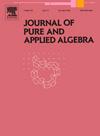Silting interval reduction and 0-Auslander extriangulated categories
IF 0.7
2区 数学
Q2 MATHEMATICS
引用次数: 0
Abstract
We give a reduction technique for silting intervals in extriangulated categories, which we call silting interval reduction. It provides a reduction technique for tilting subcategories when the extriangulated categories are exact categories.
In 0-Auslander extriangulated categories (a generalization of the well-known two-term category for an Artin algebra Λ), we provide a reduction theory for silting objects as an application of silting interval reduction. It unifies two-term silting reduction and Iyama-Yoshino's 2-Calabi-Yau reduction. The mutation theory developed by Gorsky, Nakaoka and Palu recently can be deduced from it. Since there are bijections between the silting objects and the support τ-tilting modules over certain finite dimensional algebras, we show it is compatible with τ-tilting reduction. This compatibility theorem also unifies the two compatibility theorems obtained by Jasso in his work on τ-tilting reduction.
We give a new construction for 0-Auslander extriangulated categories using silting mutation, together with silting interval reduction, we obtain some results on silting quivers. Finally, we prove that d-Auslander extriangulated categories are related to a certain sequence of silting mutations.
泥沙间隔减少和0-Auslander三角化分类
我们给出了一种外三角分类中泥沙间隔的缩减技术,我们称之为泥沙间隔缩减。当外三角化的类别是精确类别时,它提供了一种倾斜子类别的约简技术。在0- auslander外三角范畴(对于Artin代数Λ的众所周知的两项范畴K[−1,0](projΛ)的推广)中,我们提供了一个关于淤积物体的约简理论,作为淤积区间约简的应用。它结合了两期淤积减少和Iyama-Yoshino的2-Calabi-Yau减少。最近由Gorsky, Nakaoka和Palu提出的突变理论可以从它推导出来。由于在某些有限维代数上,泥沙物体与支撑τ-倾模之间存在双射,我们证明了它与τ-倾约简是相容的。该相容定理也统一了Jasso在τ-倾斜约简中得到的两个相容定理。利用淤积突变给出了0-Auslander外三角范畴的新构造,并结合淤积区间的缩减,得到了一些关于淤积颤振的结果。最后,我们证明了d-Auslander外三角分类与一定的泥沙突变序列有关。
本文章由计算机程序翻译,如有差异,请以英文原文为准。
求助全文
约1分钟内获得全文
求助全文
来源期刊
CiteScore
1.70
自引率
12.50%
发文量
225
审稿时长
17 days
期刊介绍:
The Journal of Pure and Applied Algebra concentrates on that part of algebra likely to be of general mathematical interest: algebraic results with immediate applications, and the development of algebraic theories of sufficiently general relevance to allow for future applications.

 求助内容:
求助内容: 应助结果提醒方式:
应助结果提醒方式:


